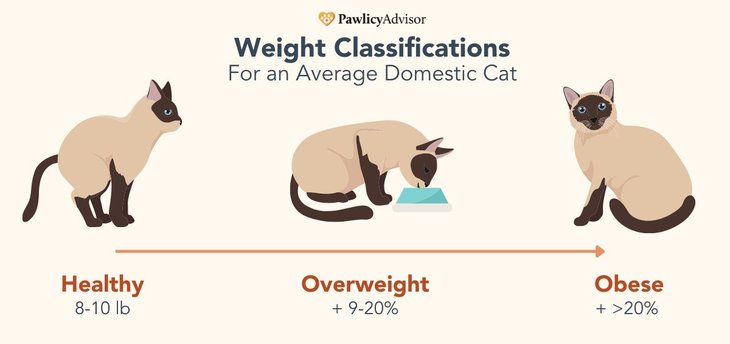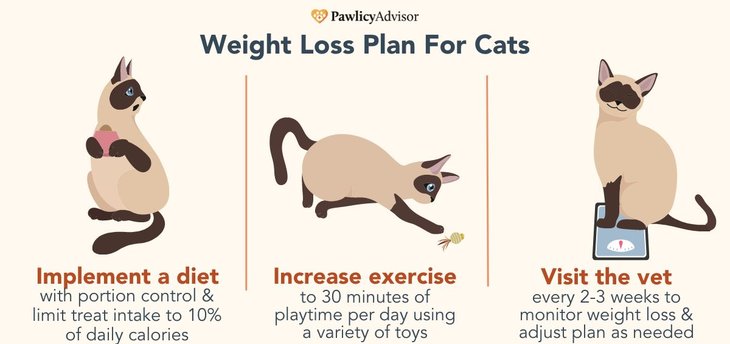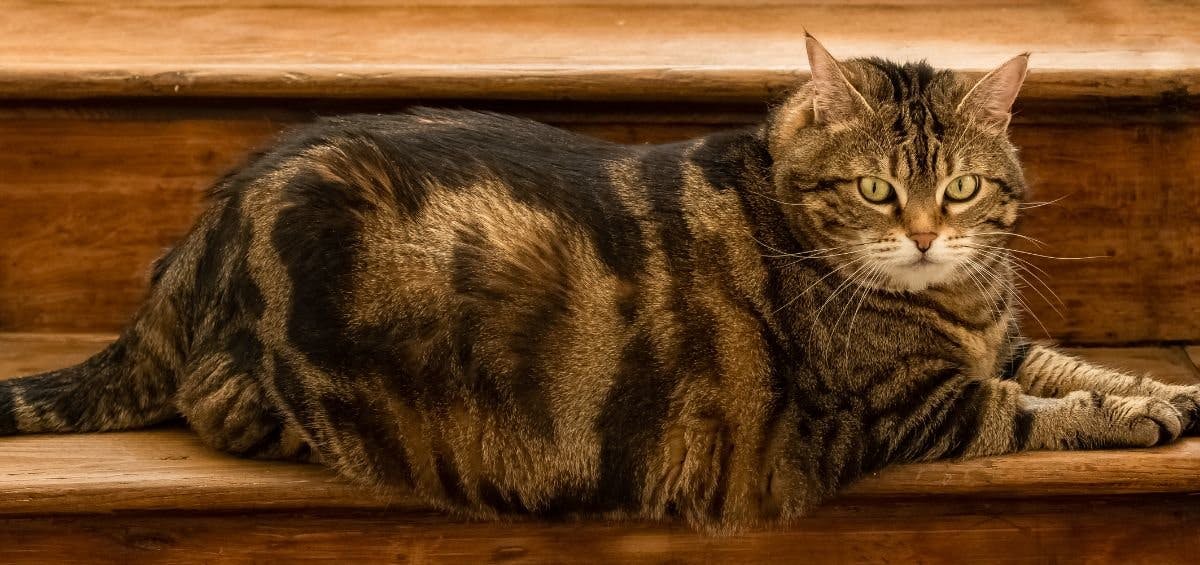Obesity In Cats: Health Risks & Consequences
You might think your chubby kitty is cute, but obesity increases the risk of many health issues in cats, including a compromised immune system, cardiovascular disease, arthritis, endocrine disorders, and more. These complications are just a few reasons why the symptoms of cat obesity should not be ignored.
If you're wondering, "Is my cat fat?" know that for nearly two-thirds of American owners, the answer is yes. Unfortunately, 59% of cats in the U.S. are classified as either overweight or obese.1
To address this epidemic, we're going to explain how to tell if your cat is overweight. We’ll also discuss what you can do to help a chubby cat lose weight in order to help pets live happier, healthier lives.
Table of Contents:
- What is overweight for a cat?
- What is an obese cat?
- Symptoms of obesity in cats
- Consequences of obesity in cats
- What causes a cat to become obese?
- Risk factors for obesity in cats
- Is my cat fat?
- What’s the life expectancy for obese cats?
- How do I get my cat to lose weight?
- How to prevent cat obesity
What is overweight for a cat?
While the optimal weight of a cat depends on its breed and health history, the average domestic feline should ideally weigh between 8 and 10 pounds. Cats are considered to be overweight when they reach 9 to 20% above their ideal body weight — meaning a cat that weighs just 0.72 to 2 pounds heavier than average could be considered overweight.
Overweight cats account for about 5 to 10% of the feline population. Weight gain is most likely to develop between the ages of 2 and 10 years old when cats use less energy and are therefore at an increased risk of becoming overweight.
What is an obese cat?
Obese cats are those that weigh more than 20% above their ideal body weight, causing excess fat to accumulate. About 40% of domesticated cats fall into the “obese” category.

Symptoms of obesity in cats
If you don’t own a scale but want to know if your cat is overweight, there are several signs of cat obesity that may suggest your pet is heavier than it should be:
- Lying down or sitting more than usual
- Disinterest in physical activity
- Difficulty climbing stairs or jumping
- Spine, ribs, or hip bones can’t be felt
- No discernible waist
- Dirty or messy coat
- Less frequent bowel movements
Consequences of obesity in cats
Obese cats are more likely to develop a number of serious health conditions, including:
- Reduced lifespan
- Chronic inflammation
- Arthritis and faster joint degeneration
- Skin and coat issues
- Respiratory disorders
- Anesthetic complications due to heat intolerance
- Metabolic and endocrine disorders
- Hepatic lipidosis
- Urinary bladder stone
- Kidney dysfunction
- Diabetes mellitus
- Hypertension
- Heart disease
- Many types of cancer
- Difficulty fighting infectious diseases
- Reduced lifespan
What causes a cat to become obese?
The number one reason why the cat obesity epidemic exists in the U.S. comes down to pets' over-eating habits. Here are several common examples that cause or contribute to weight gain in cats, many of which you may not be aware of at home:
- Rapid food consumption: If your cat eats too quickly, they might become bored, cry, or beg, prompting you to serve them more food off schedule in order to keep them quiet.
- Type of diet: A diet consisting predominantly of dry food promotes weight gain in cats more than a diet consisting wholly or primarily of canned food.
- Inaccurate food measurement: When it comes to food, it's crucial to be consistent. Use a scoop with a known measure and feed in a bowl that's appropriate for the measured food you’re offering.
- Too many treats: Treats are heavier in fat and calories than regular cat food, so giving too many treats throughout the day rapidly adds up calories to your pet’s overall daily intake.
- Indulgent feeding practices: Feeding one or two large meals throughout the day might increase the likelihood of obesity when compared to feeding small, frequent meals or offering free-choice feeding.
New data reveals a staggering 114% increase in diagnoses of overweight or obese cats over the last decade.2. This statistic is particularly troubling given the health consequences known to frequently arise with feline weight gain.

Risk factors for cat obesity
While all felines are susceptible to gaining weight, there are four factors that increase the risk in obesity in cats: age, gender, underlying medical conditions, and housing (environment) .3
- Age: Cats between the ages of eight and 12 (middle-aged) are more likely to be overweight compared to younger or senior felines.
- Gender: Spayed female and neutered male cats tend to have a stronger appetite compared to intact cats. On average, neutered male cats have the highest risk of becoming overweight or obese.
- Underlying medical conditions like arthritis can reduce a cat’s mobility, increasing the risk of weight gain. Food allergies, on the other hand, can make choosing weight-management food difficult.
- Environment: Cats who live indoors are more likely to become overweight due to inactivity than cats who live outdoors.
Is my cat fat?
If you’re still wondering, “Is my cat fat?” and don’t own a scale, the body condition score (BCS) chart can help assess your pet's weight. Veterinarians use the BCS system, which consists of 9 different body condition scores, to identify where a cat’s weight falls in relation to its health.
Body Condition Score | Description |
|---|---|
1 | Emaciated - no noticeable fat and the backbone and ribs are visible from a distance |
2 | Severely underweight |
3 | Underweight - backbone and ribs might be visible and can be easily felt; waist is clearly noticeable and there is very little belly fat |
4 | Slightly underweight |
5 | Healthy weight range - ribs can be felt and there is a very thin fat layer around the belly; waist is noticeable behind the ribs |
6 | Slightly overweight - the belly is noticeably round and the ribs are difficult to feel beneath a moderate layer of fat |
7 | Overweight |
8 | Obese |
9 | Morbidly obese - no visible waist; ribs cannot be felt; heavy fat deposits are present around the cat’s abdomen, lower back, limbs and face |
Note: While a cat's body condition score can indicate whether they fall into a healthy weight range, only a veterinarian can diagnose cat obesity and screen for secondary complications.
What’s the life expectancy for obese cats?
Statistics show that obese cats have an average life expectancy of 5 to 10 years old, which is 5 years shorter than the typical 10- to 15-year lifespan of healthy cats.4 Obese cats between the ages of eight and 12 have a 2.8-fold increased mortality rate when compared to their lean counterparts.
Obesity shortens a cat's life and increases its risk of becoming sick. However, a cat's lifespan can be reduced even if it is somewhat overweight.
How do I get my cat to lose weight?
Helping an obese cat lose weight will require time, patience, and commitment. Talk to your vet to strategize a weight-reduction regimen for your feline friend.

How to get a cat to lose weight
Your plan of action should consist of three components:
- Implement a diet
- Increase exercise
- Follow-up with vet
How to put a cat on a diet
Putting your feline friend on a diet can be tough because hungry cats often beg annoyingly for food. Here are a few tips for a feline weight-loss diet:
- Schedule meal times in order to avoid free feeding
- Change to high-calorie dry food, as you may accidentally overfeed cats on wet food diets and inadvertently worsen dental disease
- Manage your pet’s portions by measuring the food
- Feed your pet more meals with smaller portions
- Reduce the intake of treats that are very high in calories. Make sure that treats make up less than 10% of your cat’s daily caloric intake
How to exercise an overweight cat:
- Play for 30 minutes each day using a variety of toys. If you are constantly begging for food, try engaging them in play instead of giving them food. Your cat might forget their desire for food once they have your undivided attention.
- Go for a walk. If your cat has the right temperament for it, use a leash and harness (not a collar) to take them for a stroll around the neighborhood. Use treats to help your pet get used to the leash and learn how to enjoy the process. If your cat doesn’t venture outside, encourage walking up and down stairs by using a harness or moving the feeding bowls.
- Make your cat work for their food using puzzle feeding or scatter feeding. If your cat is indoor-only, consider placing their meals on an elevated surface to encourage jumping.
How often to check in with the vet:
Regular weigh-ins are an important component of successful cat weight loss and help to keep everyone accountable. The Association for Pet Obesity Prevention (APOP) recommends scheduling vet appointments every two to three weeks (or once per month at the minimum) to track your cat’s weight and BCS.5
Although the cost of vet visits may add up quickly, unchecked medical issues can cost even more — especially if obesity leads to a chronic and severe condition like cancer, which often costs upwards of $10,000 to treat. Pet insurance offers financial protection by covering 60 to 100% of the vet bill after your deductible is met.
How to prevent cat obesity
While obesity is a potentially fatal condition, it is preventable if you schedule a thorough exam with your veterinarian and work together to create a good weight management plan.
It should be noted that cats that become overweight as young kittens are more likely to be overweight or obese in adulthood. For that reason, it’s very important to prevent obesity at an early age.
Ask your vet to help you pick the most adequate cat food. Young kittens need food that is developed for their life stage and meets their individual nutritional demands rather than all-purpose cat food. Your vet can also advise you on the ideal time to transition from kitten to adult food.
Adult felines have different nutritional requirements than kittens, therefore a kitten formula isn't the best option. Senior cats are in a distinct life stage and require a different composition to maintain their health. Furthermore, cats with particular medical disorders or diseases require highly specific nutrition.
Key Takeaways
- Obesity in cats is defined as being overweight by more than 20% of the ideal body weight. Nearly 60% of cats are obese or overweight, making this condition the most common nutritional disorder among cats.
- Cats become overweight by consuming more calories than they use. Other risk factors for cat obesity include age, gender, environment, and underlying health conditions.
- Overweight cats are at risk for a variety of health issues, including heart disease, high blood pressure, immune suppression, diabetes mellitus, arthritis, and some forms of cancer.
- You can use the body condition score (BCS) to determine if your cat is overweight.
- BCS scores pets from 1 to 9, with a score of 4.5-5 representing the target weight range.
- An effective cat weight-loss program involves three components: increasing the amount of exercise your cat receives, modifying the way you feed your cat, and scheduling weighing appointments with your vet on a regular basis.
References:
- Association For Pet Obesity Prevention (APOP), "Home Page" Accessed Dec. 30, 2022.
- Banfield, "New Data Reveal Pet Obesity Epidemic Existed Long Before Quarantine" Accessed Dec. 30, 2022.
- Frontiers in Veterinary Science, "Owner and Cat-Related Risk Factors for Feline Overweight or Obesity" Accessed Dec. 30, 2022.
- VCA Hospitals, "Obesity In Cats" Accessed Dec. 30, 2022.
- APOP, "Weight Reduction in Cats" Accessed Dec. 30, 2022.
Do you want to find the best pet insurance?
Let's analyze your pet's breed, age, and location to find the right coverage and the best savings. Ready?
Analyze My PetAbout Pawlicy Advisor
The pet insurance marketplace endorsed by veterinarians, at Pawlicy Advisor we make buying the best pet insurance easier. By comparing personalized coverage and pricing differences we can save you a ton of money, up to 83% in some instances!
Instantly Compare Pet Insurance Plans
Guides
Determine If Pet Insurance Is Worth It
Comparison Charts
Find Your State
Dog Insurance
DVM
Ricky Walther, DVM, is a small animal general practitioner in the greater Sacramento, California area. Realizing the positive financial and medical impact that pet insurance can provide for pet parents and the profession, he lends support and advice to companies like Pawlicy Advisor "The Pet Insurance Marketplace") that simplify the process of connecting with veterinary financing resources.
